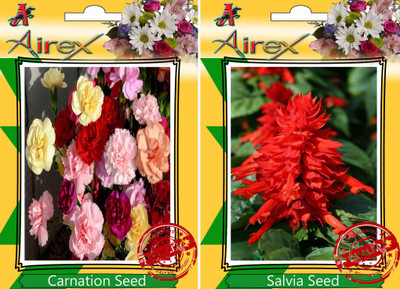Airex Carnation, Salvia Seed(15 per packet)
Quick Overview
Product Price Comparison
Carnation Flower Seeds:Description:Pretty flowers in shades of red, maroon, pink and magenta bloom atop compact mounds of foliage usually grey-green, blue-green or deep green. Flowers bloom prolifically in early summer, but some may re-bloom in fall if the spent flowers are removed. They make a terrific border or edging plant and also look great planted in mass.Salvia Flower Seeds:DescriptionSalvia species include annual, biennial, or perennial herbs, along with woody subshrubs. The stems are typically angled like other members in Lamiaceae. The leaves are typically entire, but sometimes toothed or pinnately divided. The flowering stems bear small bracts, dissimilar to the basal leavesŌĆöin some species the bracts are ornamental and showy.The flowers are produced in racemes, or panicles, and generally produce a showy display with flower colors ranging from blue to red, with white and yellow less common. The calyx is normally tubular or bell shaped, without bearded throats, and divided into two parts or lips, the upper lip entire or three-toothed, the lower two-cleft. The corollas are often claw shaped and are two-lipped. The upper lip is usually entire or three-toothed. The lower lip typically has two lobes. The stamens are reduced to two short structures with anthers two-celled, the upper cell fertile, and the lower imperfect. The flower styles are two-cleft. The fruits are smooth ovoid or oblong nutlets and in many species they have a mucilaginous coating.Many members of Salvia have trichomes (hairs) growing on the leaves, stems, and flowers, which help to reduce water loss in some species. Sometimes the hairs are glandular and secrete volatile oils that typically give a distinct aroma to the plant. When the hairs are rubbed or brushed, some of the oil-bearing cells are ruptured, releasing the oil. This often results in the plant being unattractive to grazing animals and some insects.


